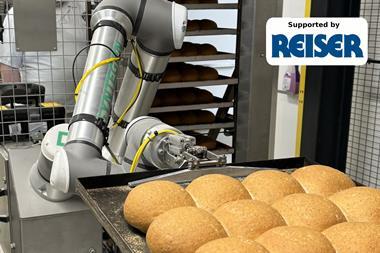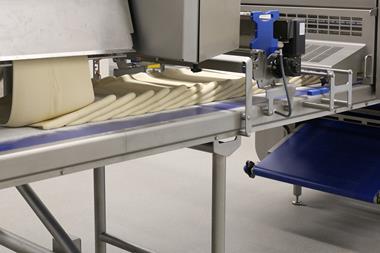Demand for an ever-wider range of bakery products – particularly those with artisan-style credentials – is one of the key factors driving the development of bread and roll plant
We all know how demanding consumers are and that it’s the job of bakery businesses to keep up with them or fall by the wayside. This means bakers have to be demanding when it comes to the equipment they use, particularly with regard to bread and roll plant.
As a result, says Terry O’Donoghue, adviser to Burford Bakery Solutions, very few projects the company is involved with can be fulfilled with off-the-shelf equipment. “We are constantly adapting and increasing the flexibility of our systems and technology to meet the needs of our customers,” he explains.
This is due to the constant desire to offer variations on the many bread and morning goods on the market, adds O’Donoghue.
He holds up bread and bun producers that supply the fast food chains as one example of growing demand for variation that has affected equipment evolution.
“Over the past two to three years Burford’s ability to handle a far greater range of toppings – and still keep within the brief of dosage control and minimal wastage – has driven great advances in machine technology,” he says.
Bread production lines have had to become much more flexible, according to Rademaker sales manager Joris Ros.
“Where bakers first required a production line for three different bread products, that has now shifted towards a multifunctional bread line that is capable of handling, for example, traditional thin/sandwich bread, artisan-style breads and even flatbreads,” he says.
Such demand prompted the development of Rademaker’s Crusto bread sheeting line. The manufacturer opted for sheeting technology over a traditional system because it enables high-capacity handling of a variety of dough types, from ‘green’ to pre-fermented dough.
“By using stress-free dough sheeters and laminating technology, we can achieve basically any dough and bread structure desired,” says Ros. “Our Crusto Breadline concept allows customers to combine traditional bread with artisan bread types, all produced on one sheeting system.”
Demand for artisan-style breads is another factor driving equipment development. For Burford, this has meant heavy investment in total enrobing, versatile water-splitting systems and glazing systems that can handle greater varieties of glazes and oils.
Kaak Group is also embracing the artisan opportunity, with the development of advanced sheet and form lines; gentle dough handling and proofing systems; and stone hearth oven technology.
“We see the UK consumer increasingly wanting more traditional products with fermented doughs, sourdoughs and oven-bottom breads produced to deliver taste and crust that may once have only been available from the local craft or artisanal baker,” says Kaak Group UK director David Marsh. “We are able to bring fully automated lines to those producers looking to invest in equipment to produce ‘artisanal styled’ bread, where the ingredients are flour, water, yeast, a bit of salt and time.”
Another key consumer trend is growing interest in free-from products – and equipment suppliers such as Rondo are working with their customers to meet this.
“It is common to find customers working in our ‘Dough-how’ centre in Burgdorf, Switzerland, developing new products, often with ingredients’ manufacturers in tandem,” says general manager Richard Tearle. “The challenge of sticky, difficult-to-handle doughs is one we face regularly, in many cases developing new mechanical solutions to cope with the lack of a gluten structure.”
Working with ingredient manufacturers has also helped Rademaker install gluten-free production lines for several product types.
“It is important to keep a close eye on new product trends and health regulations, and adapt to them quickly and efficiently,” says Ros. “We do this together with our technologists and bakers, but it also requires working closely with ingredient suppliers. For example, on the gluten-free trend, we worked with several ingredient partners.”
Elimination of cross-contamination is high on customer agendas, and equipment suppliers must cater to increasingly rigorous hygiene routines, with hygienic design and accessibility for cleaning and maintenance as core considerations.
“There is increasing concentration on the sanitary construction of equipment and the ease of maintaining strict hygiene regimes without equipment being rolled off-line or production processes being interrupted to carry out these routines,” says O’Donoghue. “The technology and construction of Burford’s latest generation of glazers/egg wash units, for example, is focused on this aspect as well as ever-increasing efficiency, to reduce wastage and therefore result in a cleaner operation.”
Rademaker’s Crusto bread line is equipped with a touchscreen controller that can store 60 different recipes and has a system that includes individual section control for short recipe changeover and higher production efficiency. For example, cleaning can start at the sheeting section, while production is still running in the make-up section. Automatic speed and height adjustments are automatically re-calculated and changed.
Rademaker’s Ros says that, to find the best production solution for customers, it is key to listen to their needs and analyse their existing production process.
He adds that the Rademaker Technology Centre gives the business the ability to reproduce the customer’s production situation, climate conditions and pre-processes. A multifunctional Crusto bread sheeting line is available, together with a team of Rademaker technologists and bakers.
“They work closely together with the customer to find the best possible solution for their specific situation,” adds Ros.
Rondo, meanwhile, has factories in Switzerland and Italy, with master bakers offering experience of working with equipment and dough.
“In many cases, our customers work with these guys and often this will involve personnel from ingredients suppliers as a new product is developed and tested on one of our lines,” says Tearle. “This will often result in new line components being designed to sheet or shape the product.”
While reducing headcount and improving product quality and consistency will always be a major consideration for equipment development, suppliers must also ensure they are on top of developing trends and demands.
“In terms of products and product formats, our sales teams around the world are continuously feeding back new product trends and ideas to our factories,” says Tearle. “These are assessed, and a team at head office will sift through them looking at what we can do with existing or new lines to meet the ever-moving market needs.”
This may also mean addressing a decline in demand for some product formats.
“Three years ago the demand from all the major bakeries was for ways of producing ‘thins’ efficiently,” says O’Donoghue. “Now, in America, the popularity of that product appears to have plateaued quite rapidly and shows signs of decline in popularity.”
There are also signs of a drop in interest in the UK. Volume sales of sandwich thins were down almost 20% year on year in
2016, according to IRI data – with the decline attributed to factors including slowdowns in product development and promotional activity.
Whether or not Brits are going cool on thins, it’s a safe bet that equipment manufacturers will be positioned to offer bakers the kit they need to tap whatever hot new trend comes next.
Getting to grips with the bottom line
Much consideration goes into getting the right machinery for a bakery, but what about the material the equipment sits on?
“Bakery floors can be exposed to a wide range of food stuffs and corrosive cleaning chemicals, so choosing the right product to protect the important structural concrete floor that supports the business is crucial,” says David Priest, sales manager at industrial flooring supplier Kemtile.
He adds that oils, fats and flour can make a floor slippery, potentially exposing the business to costly personal injury claims.
“And cleaning chemicals and some bakery oils can also attack the concrete, forming voids where bacteria can grow.”
Although each bakery has its own flooring and drainage requirements – depending on whether they are a small craft bakery or a large batch production plant – Priest says certain key considerations and specifications apply to the whole bakery sector:
It is essential that bakery flooring can be easily cleaned to meet current legislation and help remove any build-up of spillages that could cause unnecessary slips.
Some cleaning chemicals used in food processing environments can attack concrete, so a floor finish with good all-round chemical resistance is a definite requirement.
Bakery floors need to have good resistance to elevated temperatures – such as areas around ovens where there may be hot racks – and to hot water cleaning or pressure washing as undertaken around the utensil and wash bays.
Drainage in bakeries, although not extensive, is also important. Drainage – which tends to be small gullies for general cleaning or channels in wash bays – should be hygienic, easy to clean and should be made of stainless steel.
Durability is a key factor as bakeries are aggressive environments with hot racks, mixing vessels, trays being dropped and forklift trucks all taking their toll. Hard-wearing systems with a long performance history are a must to provide long-term protection.
Kemtile recently fitted the Kagetec AR system at Brioche Pasquier’s new 6,000sq m bakery in Milton Keynes. Laid throughout the plant, it is capable of withstanding thermal, mechanical and chemical stresses, and should require little maintenance besides cleaning, says Kemtile.
Rise of the machines?
Robots have been tipped as the next big thing in helping bakers save costs on activities such as picking, placing and sorting products.
ABB Flexpicker robots are used at Honeytop Speciality Foods, for example, to pick 110 pancakes a minute into stacks. Four cameras are integrated, enabling the robots to track the pancakes’ positions and recognise overlapping products. The programming software can be changed to suit various shapes and sizes so that other products, such as flatbreads, can also be picked, meaning turnaround time between switch-overs has been dramatically reduced.
Robots can also help in other areas such as cutting and decorating bakery products. Specialist robot system integrators have discovered ways to efficiently cut products such as cakes and pies in a variety of shapes, using robots tooled with ultrasonic blades.
There are cost savings too. For example, robot cutting technologies result in less wastage, saving expenditure on highly priced ingredients, says ABB. In addition, when manual labour is replaced by robot technology, staff can be moved to areas of the business that are more rewarding and creative.
ABB is running a Switch to Robots seminar this month (26 April) to demonstrate how robots could increase flexibility at bakeries.
Jet system helps smooth out coatings
Millers Bespoke Bakery, a wholesale bakery serving diverse markets, produces brioche hamburger buns at the rate of 18,000 an hour from two sites in south London.
The business applies an egg glaze to these products. This can be applied manually or, in the case of large-scale production, using coating systems – such as those with air-atomising nozzles or a spinning disc – to create a spray of fine droplets, enveloping the buns as they pass along a conveyor.
Millers managing director Marcus Miller was dissatisfied with the performance of the bakery’s triple spinning disc system and, working with chief engineer Colin Mellish, decided to install a fully-automated nozzle and control system.
Developed and manufactured by Spraying Systems Co, the AutoJet system installed has two essential elements: the 2008+ controller and PulsaJet spray nozzles. The nozzles are electrically actuated to turn off and on repeatedly, up to 15,000 times a minute, with flow rate, spray angle and droplet size held constant. In a conventional spray system these values would vary with line pressure.
The glaze application rate is determined by setting the percentage of time for which the spray is switched on. The system automatically monitors line speed, instantly adjusting nozzle flow rate as conveyor speed varies. The transfer efficiency of the egg glaze between nozzle and burger bun is greatly improved by spraying exactly what is required on each product, says Spraying Systems Co. As a result, Millers has reported a 50% reduction in real egg glaze usage.














































No comments yet